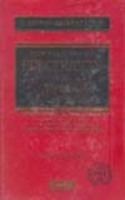Law Of Electricity In India
Author: S. Krishnamurthi Aiyar
Publisher: Universal Law Publishing Co Ltd
ISBN: 9788175347175
Pages: 1915
Add to Booklist
Publisher: Universal Law Publishing Co Ltd
ISBN: 9788175347175
Pages: 1915
Electricity has crept forward all unconsciously through the outpost of the past, out-manoeuvred prejudice and overrun precedent. Today it has become an everyday factor in facilitating industrial operations and in adding to the comforts and conveniences of domestic life. Truly, the age in which we live may be called an age of electricity. No doubt there exist in the market some books dealing with the subject of electrical energy. But almost all of them mainly deal with its technical side. There appeared to be a great need for an exhaustive and up-to-date work in which both legal and technical branches of the subject are fully dealt with. In this volume where the legal aspect has been given the importance it deserves, the technical aspect has not been neglected. The aim of this work is to provide the lawyer as well as the layman user of electricity and also the staff of an electricity undertaking, all essential points concerning the law and practice relating to the supply and use of electrical energy. I have, amongst other things, included in this book the Indian Electricity Act, 1910 (IX of 1910), the Indian Electricity (Amendment) Act, 1937, the Rules and Regulation Continuance Act, 1937, the British Electric Supply Acts, Extracts from relevant Acts, the Indian Electricity Rules, 1937, Notifications, Forms of licences, Specifications, Instructions, etc., issued by the several Provincial Governments in India. For purposes of easy reference, I have grouped all these Notifications, instructions, etc., relating to each Provincial Government in a separate appendix. There being a paucity of Indian case law on the subject, legal principles have been illustrated by English and Empire case law wherever necessary. It is my hope that this book will serve as a vade mecam for all consulting engineers, local authorities, actual or prospective licensees, officials of the public works and the telegraph departments and the members of the Bench and Bar.
Top rated books in this category































